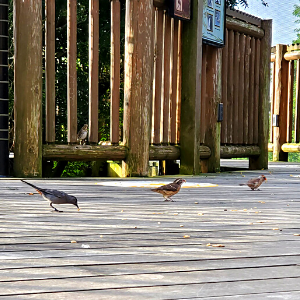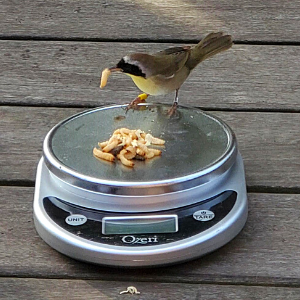The Akron Zoo’s Grizzly Ridge Aviary is home to 22 species of North American songbirds. Established in 2013, the Mike and Mary Stark Grizzly Ridge area highlights many of North America’s native species, including grizzly bears, North American river otters, red wolves, and one of the largest North American songbird aviaries within the Association of Zoos and Aquariums (AZA). The majority of the birds in our aviary were injured in their native habitat, and have now been rehabilitated and given a second chance at the Akron Zoo.
Traditionally, keepers have been relatively hands-off with these birds. However, this led to difficulties in managing this large habitat, including trying to assess each bird’s individual health and welfare daily. It can be difficult to tell birds apart when multiple individuals of that species are present, or when an individual is more secretive. One of the keepers’ main goals is to ensure each bird is seen daily and health issues are caught as early as possible, so a change had to be made.
 One way keepers have worked to increase visibility is to have each bird come to the deck for diet items. To train this behavior, the aviary deck was cleaned and old food was removed. Then, keepers would throw a couple of handfuls of waxworms on the deck. When birds landed to eat the worms, the keeper whistled in a distinct pattern to get the birds to associate the appearance of the waxworms with the sound. Soon the birds started flying to the deck in the morning at the sound of the keeper’s whistle, though sometimes before. This indicates the keeper’s presence was also a visual cue.
One way keepers have worked to increase visibility is to have each bird come to the deck for diet items. To train this behavior, the aviary deck was cleaned and old food was removed. Then, keepers would throw a couple of handfuls of waxworms on the deck. When birds landed to eat the worms, the keeper whistled in a distinct pattern to get the birds to associate the appearance of the waxworms with the sound. Soon the birds started flying to the deck in the morning at the sound of the keeper’s whistle, though sometimes before. This indicates the keeper’s presence was also a visual cue.
Some of the birds were so highly motivated by waxworms that they started flying towards keepers as soon as they entered the aviary to inspect for worms. Keepers opportunistically captured this behavior by holding waxworms in their hand and allowing birds to choose to land in their palm to consume them. Having birds land in a hand allows our keepers to get a closer look at the physical condition of the birds, and builds a relationship that could allow for more trained behaviors in the future. The majority of birds in the aviary find waxworms to be reinforcing enough to come to the deck more days than not, though higher-value reinforcement may be trialed in order to get more consistent success with more of the birds. This ensures each bird is eating and allows keepers to observe physical condition and social dynamics.
 Another method for increasing visibility of our birds is having each bird participate in scale training. This gives even more information and allows keepers to monitor weights and trends. This training started once the birds were consistently coming to the deck with the whistling cue. Keepers started introducing a small kitchen scale with waxworms placed on it. Some of the more outgoing birds landed on the scale right away, and the keeper was able to record their weights. For others, it took several weeks to become comfortable around the new item, and longer still for them to eat from the scale. For some birds, this was the first weight taken since they had moved into our aviary, so this was a huge success in being able to better monitor their health. Currently, about 20 of the birds regularly participate in the scale training.
Another method for increasing visibility of our birds is having each bird participate in scale training. This gives even more information and allows keepers to monitor weights and trends. This training started once the birds were consistently coming to the deck with the whistling cue. Keepers started introducing a small kitchen scale with waxworms placed on it. Some of the more outgoing birds landed on the scale right away, and the keeper was able to record their weights. For others, it took several weeks to become comfortable around the new item, and longer still for them to eat from the scale. For some birds, this was the first weight taken since they had moved into our aviary, so this was a huge success in being able to better monitor their health. Currently, about 20 of the birds regularly participate in the scale training.
In the future, we hope that each one of these behaviors (scale, come to the deck, and come to the hand) would be cued, completed by the bird, and then reinforced. Currently, these behaviors are primarily completed using baiting techniques, but progress is being made toward transitioning the birds to a more formally trained behavior. Future training goals include a station behavior, recall into the indoor area, and a kenneling behavior. There are also plans to set up RFID sensors in the aviary for research and daily monitoring purposes. Most of the birds currently have RFID bands, and the zoo is just waiting on the software to set up existing sensors in the aviary.
Introducing these trained behaviors to the management of our aviary has already increased daily visibility of our birds, improved relationships between the birds and keepers, and allowed for better monitoring of the birds’ health. There are many more future possibilities for training in this aviary, and we look forward to continuing to increase welfare for our birds and improve the guest experience at the Akron Zoo. We hope to see you soon!
